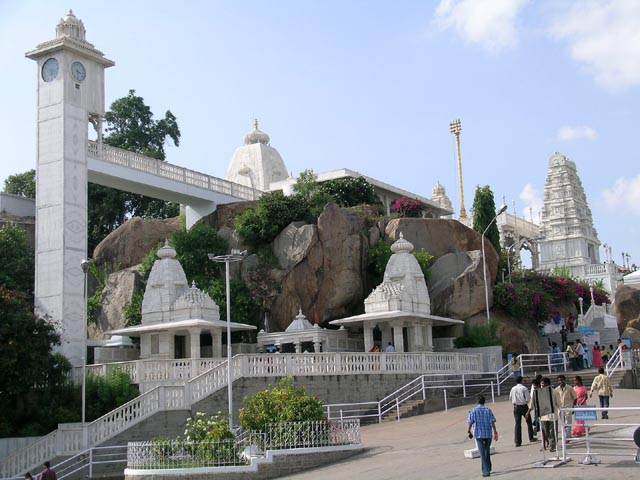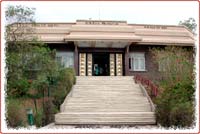Industrialists Birlas have built a number of temples of architectural magnificence
all over the country which, strangely, are referred to as Birla temples and not
Lakshminarayan temple or Venkateswara temple. A quarter century ago, they built
a temple in Hyderabad entirely in marble brought from Rajasthan and dedicated it
to Lord Venkateswara, known as Balaji in the north. The temple, built on a hillock
called Kala Pahad, one of the Naubat Pahad twins, lords over its equally celebrated
surroundings comprising the imposing Secretariat buildings, the azure-blue waters
of Hussain Sagar, the serene and halcyon Lumbini Park the luxurious Public Gardensdominated by the Asafjahi-style Legislative
Assembly complex and the Reserve Bank of India. From the highest level of the temple,
the spectacle around is breath-taking, providing a view of the verdure of the city,
the incessant flow of traffic on the Tank Bund, crowds thronging the administrative
complexes of the government, the newly-built flyovers and the cultural hub of the
city Ravindra Bharathi and the NTR Memorial.

The approach to the temple is through a lane opposite the Reserve Bank, and once
you trek this small patch, you reach the foot and both sides of a meandering stairway
flanked by ornate banisters. On the way are several marble statues representing
the Hindu pantheon. The temple manifests a blend of South Indian, Rajasthani and
Utkal temple architectures. Before you reach the sanctum, several structures beginning
with the baroque canopies at the foot of the stairway, greet you. The main temple
is entered through the four-tiered rajagopuram built in the garudalaya style of
South Indian temples. Beyond the rajagopuram swings into presence the great Dilwara
temple-style gallery dwarfing nearly every other structure by its intricately carved
detail.
The 11-feet tall statue of Lord Venkateswara in the sanctum sanctorum is sculpted
from black granite, specially mined and brought from Phirangipuram in Guntur district.
This is very different from the white marble statues that one sees in other temples
built by the Birlas. Over the statue is a lotus-shaped canopy done in marble again.
The tower of the main temple called the Jagadananda vimanam has a close resemblance
to the architecture of the Lingaraj temple at Bhubaneswar. Overlooking the presiding
deity is the brass dhwaja stambham soaring to a height of 42 feet. In the adjoining
mukhamandapam are several sculptures in marble depicting scenes from the Hindu mythology,
the Ramayana and Mahabharatha in particular. The temple towers for the Lord’s two
consorts Padmavathi and Andal are built in South Indian style, unlike the Utkal
architecture marking the main temple.
If you are an early bird, you can catch the melodies of Venkateswara suprabhatam
as early as 5:30 in the morning followed by devotional numbers of Annamacharya,
Thyagaraja and Bhakta Ramadas. If you come for a second look in the evening, the
whole temple complex is bathed in an aura of flood-lit glory. Temple rituals here
are done according to agama shastras, the pancharatra agama in particular. Venkateswara temple on the hillock is a place where you
are bound to forget grief and greed for the while you are there. The temple itself
is cradled amidst tall and ancient trees, manicured and well-maintained lawns, and
formal gardens. Birla Mandir is the centrepiece of the capital city’s skyline.
Birla Science Centre
On the same hillock is another Birla gift to the nation, the Birla Science Centre
which inculdes the more well known Planetarium. The Science Centre is another beautiful
structure, reflecting the advances made in science and technology. It is a great
draw with students aspiring to become C.V. Ramans and Shantiswaroop Bhatnagars.
The interior décor matches the architectural exterior of the Centre built over 10,000
Sq. Ft. and designed by architects from Calcutta and Bombay who drew upon concepts
and ideas from Japan, Hong Kong and Singapore. The Centre is host to a number of
divisions such as the Planetarium, the Science Museum, and the Centre for Applied
Mathematics and Computer Sciences.
Birla Planetarium
The Planetarium is another magnificent building with a big dome resembling that
of the Gol Gumbaz in Bijapur and some of the earliest government structures in New
Delhi. A star attraction here are the spectacular sky shows every day with Telugu
and English commentaries. The shows unveil the mysteries of the cosmos and the origins
of the universe, the comets, eclipses, unidentified flying objects and the clash
of titans. The sky show opens with the projection of the galaxy over the spectator's
heads producing the illusion of sky and space. These projectors are the most modern
and sophisticated of their kind in the country. The accompanying music adds to the
experience of virtual reality. It is difficult to imagine how our ancestors could
observe these phenomena thousands of years ago without the kind of equipment we
have today.
 The Planetarium has now added to itself a Dinosorium showcasing a variety of exhibits
including a 160-million-old mounted Kotasaurus Yamanapalliensis excavated in Adilabad
district and gifted to the Science Museum by the Geological
Survey of India. You
can also see here a collection of smaller fossils of dinosaur eggs, marine shells
and fossilised tree trunks. While Birla temple symbolises the mystique of the spirit,
the Science Centre symbolises the unknown realm of matter.
The Planetarium has now added to itself a Dinosorium showcasing a variety of exhibits
including a 160-million-old mounted Kotasaurus Yamanapalliensis excavated in Adilabad
district and gifted to the Science Museum by the Geological
Survey of India. You
can also see here a collection of smaller fossils of dinosaur eggs, marine shells
and fossilised tree trunks. While Birla temple symbolises the mystique of the spirit,
the Science Centre symbolises the unknown realm of matter.
|